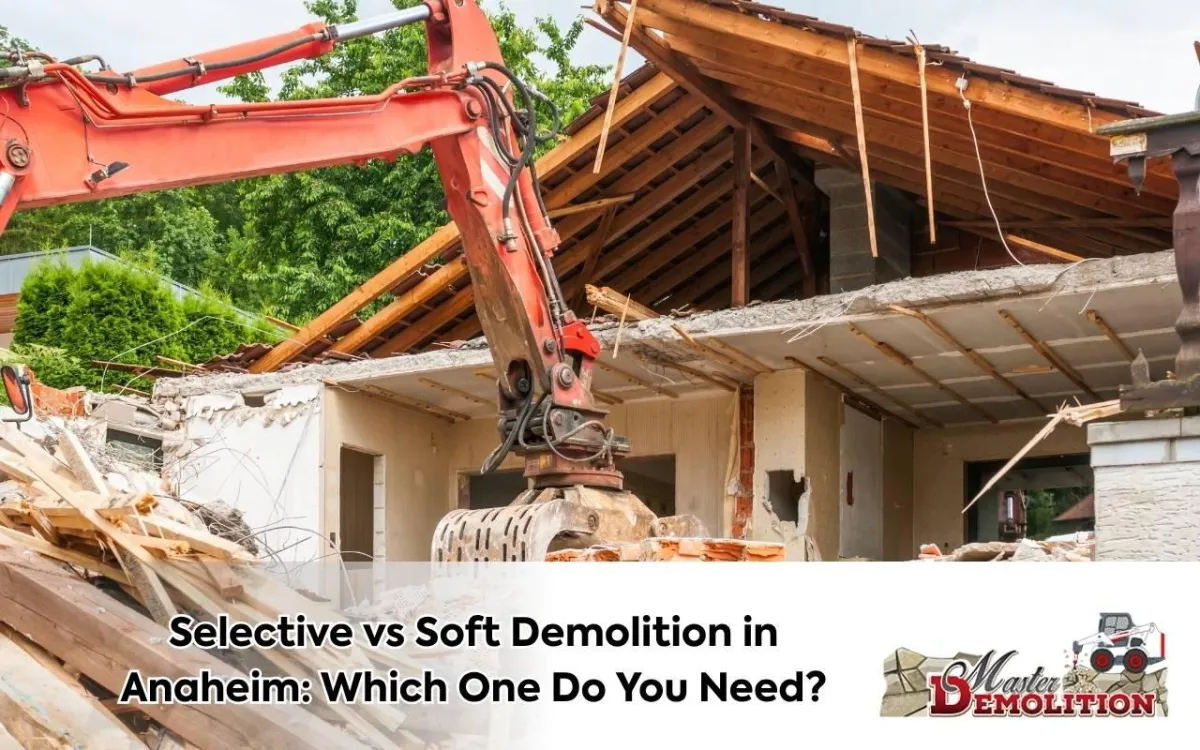
Selective vs Soft Demolition in Anaheim: Which One Do You Need?
Demolition might conjure images of wrecking balls and dust, but the reality in Anaheim is more nuanced. Whether you're revamping interiors or managing tenant improvements, understanding the difference is crucial. Selective demolition vs soft demolition Anaheim goes beyond breaking walls; it’s about precision, planning, and choosing wisely. Aligning the right approach with your project scope saves time, resources, and unnecessary stress. Modern projects demand dust containment and minimal disruption. Therefore, your decision must ensure seamless transformation. Let’s explore both methods to help you choose effectively.
Understanding Selective Demolition
Selective demolition, often called surgical removal, targets specific structural parts without affecting surrounding areas. This method supports commercial projects, especially tenant improvements. Selective demolition vs soft demolition Anaheim emphasizes precision and sustainability, reducing waste and preserving building components. Proper planning defines sections to remove, utility reroutes, and dust control measures. Clear scopes of work ensure operational continuity during renovations, especially where downtime is costly. This approach offers precision, meeting strict deadlines and complex requirements in commercial or retail environments.
Benefits of Selective Demolition in Anaheim
Minimized disruption to daily operations through advanced dust control.
Cost savings by reducing waste disposal and supporting recycling.
Preservation of architectural features in historic or unique spaces.
Improved project sustainability through material reuse.
Selective demolition vs soft demolition Anaheim ensures efficiency, budget control, and protection of valuable building character. For commercial properties, this translates into smoother operations during construction.
Need expert help with your next project? Contact us today and let’s discuss your renovation goals.
Process of Selective Demolition
The process begins with site assessment and scope definition. Contractors isolate utilities like power, water, or HVAC. Once secured, crews use handheld tools, small hydraulic breakers, and non-destructive methods. Negative air machines, plastic sheeting, and HEPA vacuums ensure effective dust containment. Selective demolition vs soft demolition Anaheim highlights safety, planning, and environmental care.
Selective Demolition Best Practices
Identify and secure utility lines before work begins.
Use clear markings, signage, and safety briefings on site.
Maintain strong communication between project managers, contractors, and tenants.
Document salvaged materials for compliance and cost tracking.
Exploring Soft Demolition
Soft demolition, sometimes called deconstruction, dismantles non-structural components systematically. It focuses on finishes like drywall, carpet, fixtures, and trim. Selective demolition vs soft demolition Anaheim differs in tools and goals. Soft demolition relies mainly on manual methods for controlled results. This process aligns with sustainability through material salvage and reduced landfill impact. It also offers quieter, low-vibration work, ideal for medical or multi-tenant spaces.
Advantages of Soft Demolition in Anaheim
Supports recycling by salvaging flooring, cabinetry, and fixtures.
Reduces noise and vibration in sensitive environments.
Keeps adjacent areas operational with dust containment methods.
Aligns with Anaheim’s sustainability goals.
Soft demolition makes projects more environmentally conscious. To learn more about eco-friendly demolition services, visit our demolition services page.
Soft Demolition Techniques
Techniques include using pry bars, oscillating tools, and floor scrapers for controlled removal. Contractors carefully de-nail finishes to preserve materials for reuse. Flooring is removed with minimal damage to the subfloor. Built-in fixtures and cabinetry are labeled and disassembled for potential resale. Selective demolition vs soft demolition Anaheim provides distinct strategies tailored to each project’s scope.
When to Choose Soft Demolition Over Selective Demolition
Soft demolition works best for cosmetic upgrades and tenant rollouts. Use it when refreshing finishes or replacing fixtures without structural changes. Selective demolition is better for rerouting utilities or reconfiguring layouts. Choosing between selective demolition vs soft demolition Anaheim depends on scope, budget, and sustainability goals.
FAQs About Demolition in Anaheim
What is the main difference between selective and soft demolition?
Selective focuses on structural changes, while soft targets finishes and non-structural elements.
Which method is less disruptive for tenants?
Soft demolition is quieter and less invasive, making it ideal for active spaces.
Can selective demolition support sustainability?
Yes, by reusing materials and minimizing waste, selective demolition contributes to eco-friendly practices.
When should I use soft demolition?
Use soft demolition for cosmetic updates or when structural preservation is a priority.
Do I need permits for both types of demolition?
Yes, permits are typically required. Your contractor will guide you through the process.
Selecting the Right Demolition Approach for Your Project
Begin by defining scope and operational needs. If you prioritize recycling, soft demolition may be ideal. For structural updates, selective demolition offers precision. Engage professionals early for clear timelines and compliance. To explore project-specific options, visit our pool demolition services or concrete demolition solutions.
Making Informed Choices for Successful Renovation
Your choice between selective demolition vs soft demolition Anaheim depends on project goals. Consider timelines, sustainability, and operational continuity. With the right approach, you’ll achieve safe, efficient, and successful renovations. Partner with experts to ensure your project’s success from start to finish.